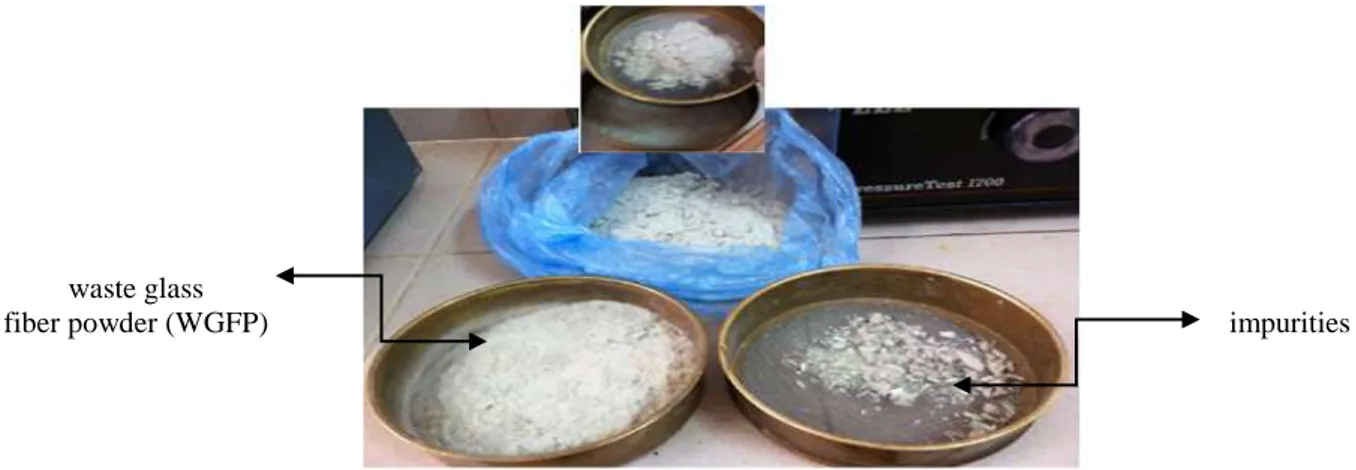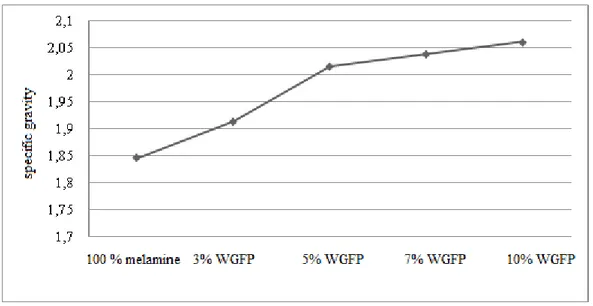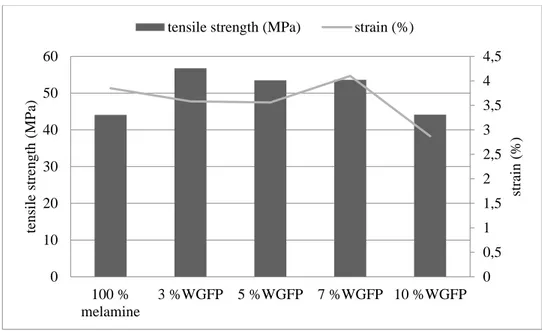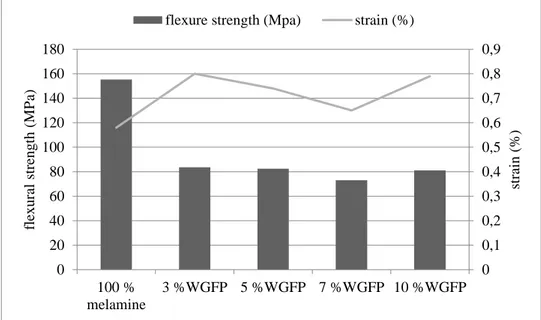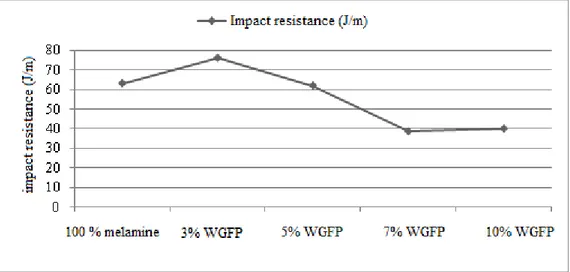Kahramanmaras Sutcu Imam University
Journal of Engineering Sciences
Geliş Tarihi : 10.01.2020 Received Date : 10.01.2020
Kabul Tarihi :03.05.2020 Accepted Date : 03.05.2020
MECHANICAL AND IMPACT PROPERTIES OF WASTE GLASS FIBER
POWDER REINFORCED MELAMINE COMPOSITES
ATIK CAM ELYAF TOZU TAKVİYELİ MELAMİN KOMPOZİTLERİN
MEKANİK VE DARBE ÖZELLİKLERİ
Hayriye Hale AYGÜN (ORCID: 0000-0002-2812-8079)
1 Kahramanmaraş Sütçü İmam Üniversitesi, Elektrik Elektronik Mühendisliği Bölümü, Kahramanmaraş, Türkiye *Sorumlu Yazar / Corresponding Author:Hayriye Hale AYGÜN, hhalesolak@hotmail.com
ÖZET
Cam elyafı, kompozitlerin mekanik özelliklerini artırmak için kullanılan en popüler takviye elemanıdır. Filament halde üretilen cam elyafını, kırpılmış cam elyaf formuna dönüştürme esnasında yüklü miktarda atık cam elyaf açığa çıkmaktadır. Bu çalışma melamin matrisli kompozitlerde atık cam elyaf tozunun kullanılması üzerinedir. Sıcak pres yöntemiyle üretilen atık cam elyaf tozu takviyeli melamin kompozit numunelerin çekme dayanımı, eğilme direnci, özgül ağırlığı ve darbe dayanımı ölçülmüştür. Test sonuçları kompozit malzeme üretiminde kullanılan takviye elemanının fiziksel formunun son ürün karakteristiği üzerinde çok önemli bir etkiye sahip olduğunu göstermiştir. Numunelerin özgül ağırlığının, kompozitteki atık cam elyaf tozu takviyesi oranı arttıkça yükseldiği görülmüştür. Özgül ağırlık sonuçlarındaki bu değişim, melamin matrisin sıcaklık ve basınç uygulaması sonucunda takviyeli ve takviyesiz numunelerde yeniden düzenlenmesinden ve takviyeli numunelerde atık cam elyaf tozunun ısıya karşı duyarlığının melamin matrise oranla düşük olmasından kaynaklanmaktadır. Atık cam elyaf takviyesinin çekme dayanımını ve darbe dayanımını sırasıyla %30 ve %20 ye varan oranlarda artırdığı ancak eğilme dayanımını yaklaşık %50 ye varan oranlarda düşürdüğü tespit edilmiştir.
Anahtar Kelimeler: Atık cam elyaf tozu, kompozit, melamin, mekanik özellikler, darbe dayanımı ABSTRACT
Glass fiber is the most popular reinforcement material for improving mechanical properties of composites. While tranforming glass fiber filaments to chopped ones, too many waste glass fiber exists. This paper deals with waste glass fiber powder usage in composites with melamin matrix. Tensile strength behaviour, bending resistance, specific gravity and impact resistance of samples were analysed. Results showed that physical form of reinforcing agent in composite mixture was very important in characteristics of end products. Specific gravity of samples increased by increasing amounts of waste glass fiber powder in composites. This change in specific gravity is related with rearrangement of melamin matrix by hot pressing method and high temperature resistance of waste glass fiber powder to heat than that of melamin matrix. Thereto, waste glass fiber powder reinforcement enhanced the tensile resistance and impact strength of composite up to 30% and 20%, respectively. Addition of waste glass fiber powder lead to sharp decrease in bending resistance, approximately 50%.
Keywords: Waste glass fiber powder, composite, melamine, mechanical properties, impact resistance
*Sorumlu Yazar / Corresponding Author:Hayriye Hale AYGÜN, hhalesolak@hotmail.com
ToCite: AYGUN, H. H. (2020) MECHANICAL AND IMPACT PROPERTIES OF WASTE GLASS FIBER POWDER REINFORCED MELAMINE COMPOSITES. Kahramanmaras Sutcu Imam University Journal of Engineering
INTRODUCTION
The term “composite” refers to a unique novel material constituting from various components with different morphological and functional characteristics. In a composite structure, the components of a composite do not dissolve within each other or bond each other with atomic forces. The aim of composite manufacturing is enhancement of a definite characteristic according to demands of usage areas (Soy, 2009). In composites, reinforcing material behave as supplementary unit improving mechanical performance of system whereas matrix material has a role of preventing system from external influences. Briefly, the components should compensate each other. Thereby, suitable matrix and reinforcing agent usage has a critical effect on mechanical and morphological properties of system. Also, manufacturing technique and conditions determine the firmness of composite structure by means of coherence between components (Rosato, 1997; Ulcay, Gemci & Akyol, 2002).
In fiber reinforced composites (FRC), manufacturing technique has a crucial effect on mechanical performance. Heavy industrial manufacturing conditions, such as; cutting or punching, are not noticable for these composites due to the risks of decomposition for continue synthetic filaments and untwisting for natural fibers. Because of various behaviours of textile materials, mechanical characteristics can differ under unsuitable production conditions (Philips, 1989). Besides, fiber diameter, generally between 7-100 μm, and concentration of reinforcing are important parameters for FRCs. Fiber concentration, an easily controllable parameter, is a manufacturing variable effecting composite behaviour chiefly (Agarwall, Bioutman, & Chandrashekhara, 2006). For manufacturing of FRCs, different types of glass fibers are known as the most versatile reinforcing material used to gain excellent properties to composite (Şahin, 2000). Over 90% of glass fiber reinforcements are done by E-type glass fibers in forms of filament bundles, chopped fibers or woven fabrics due to its lowest manufacturing cost among all commercially available glass fiber types in traditional applications, but not in special fields (Wallenberger, Watson & Li, 2001; Mallick, 1993; Callister, 2006; Hull & Clyne, 1996). Following studies have been performed on manufacturing of composites with different forms of glass fiber. Valasek and Müller (2013) studied on glass powder reinforced epoxy composites and they reported that glass powder inclusion reduced impact strength but increased wear resistance. Ku and Wong (2011) measured tensile strength behaviours of glass powder reinforced epoxy composites were measured and they claimed that glass powder was not a suitable filler and fractured surfaces were obtained. Ku and Wong (2012) tested mechanical properties of glass powder/vinyl ester composites and test results showed that strength of composites was less than neat matrix materials. Sonsakul and Boongsood (2017) produced glass fiber and glass scraps powder reinforced polyester composites and mechanical properties of composites such as impact resistance, tensile strength and flexural strength; reduced with powder reinforcement as oppose to fiber strengthening. Bhaskar and Srinivas (2017) examined mechanical properties of polyester matrix reinforced with different forms of glass fiber products such as chopped strand mat or woven rovings and they obtained that mechanical properties of chopped strand mat/polyester composites had better mechanical characteristics than those of woven rings reinforced polyester composites. Lee and Park (2017) studied on application of silane coupling agent treated chopped fiber in undulated regions of glass fiber fabric/PVC composite and they reported that each of the mechanical properties was differently affected. Nayak and Heckadka (2018) manufactured chopped strand E-glass fiber mat reinforced CNSL-epoxy composites by hand lay-up technique and they found that tensile and flexural properties of composites improved with increase in fiber content.
Thermoset polymers are commonly used as matrix element in conventional FRCs. Without heating and high pressure application, they have viscousic or processable structure which make possible to have homogeneous mixture handling with fibers. When they are exposed to heat or X-ray treatments, a three dimensional network occurs and decomposition is impossible under normal conditions. Due to firm network they gain, the composites produced from thermosets have high temperature resistance, good resistance to solvents and high dimensional stability (Trantina & Mimmer, 1993; Gibbons, 1998). Amino thermoset resins, urea formaldehyde and melamine formaldehyde, are chemically obtained from thermoset polymers and they are especially preferred for manufacturing of multi-partial composites because of their fast response to heat treatments. Despite of their structural similarities, they show different characteristics. Melamine formaldehyde resins supply desired demands due to excellent insulation properties, good resistance to scratching, high abrasion coefficients and easily cleanability for both indoor and outdoor applications (Şahin, 2006; Pizzi, 1994; Ripperger, 2005; Harper, 2002).
In composite manufacturing, glass fibers are generally used in forms of chopped, filament and mat. While cutting glass filaments for handling chopped glass fibers, huge amount of waste glass fiber exists. Pre-mentioned studies
have been performed on different types of thermoplastic/thermoset matrix reinforced with glass filament, glass mat and chopped fibers or thermoplastic matrix reinforced with glass fiber powder. This study deals with utilization of these wastes and examination the effects of waste glass fiber powder reinforcement on mechanical properties of thermoset matrix, namely melamine matrix. In this study, waste glass fiber are sifted and waste glass fiber powder is added into melamin matrix by 0%, 3%, 5%, 7% and 10 % in w. Waste glass fiber powder reinforced melamin composites are produced by hot pressing method. Bending resistance, tensile strength, specific gravity and impact resistance of samples are tested. Test results are compared with 100 % melamine reference samples produced with identical processes.
MATERIALS AND METHODS
Material
Melamin formaldehyde powder (126.12 g/mol) with density of 1.52 g/cm3 was supplied from Özgül Melamin.
Waste glass fiber (WGF) was obtained from Cam Elyaf Inc. Specifications of WGF is listed in Table 1.
Table 1. Properties of Waste Glass Fiber (WGF)
Method
WGF was sifted with a coarse screen of 1 μm. Impurities such as; glass residues and glass pellets were removed and waste glass fiber powder (WGFP) was dissociated. Sieving process is shown in Figure 1.
waste glass
fiber powder (WGFP) impurities
Figure 1. Removing of Coarse Impurities in Waste Glass Fiber
Previously prepared moulds were used to manufacture end product. By considering the tests to be performed, two different moulds had to be chosen because dimensions of samples-especially thickness- determined in corresponding standards were different (ASTM 792; ASTM 3039; ISO 178; ISO 180). WGFP was added into melamin with 3%, 5%, 7% and 10 % in vol and blended via a mechanical stirrer. These blends with different concentrations were then molded by hot pressing technique. Manufacturing process is shown in Figure 2 and process parameters of hot pressing are given in Table 2.
Variables E-type glass
Diameter Residue from chopping of various glass fiber bundles having 9-13 µm diameter
Density 2.54 gr/cm3
(a) (b) (c)
Figure 2. Manufacturing of Waste Glass Fiber Reinforced Melamine Composites; (a) mixing, (b) hot pressing, (c)
melamine composite products pressed by moulds with a thickness of 2 mm and 4 mm
Table 2. Preparation and Production Conditions
Preparation of mixture Hot pressing
Speed 250 rpm Pressure 210 bar
Period 30 min Pre-moulding 10 oC
Scouring 25 oC
Final moulding 45 oC
Temperature 23 ± 2 oC Upper mould temp. 168 ± 2 oC
Bottom mould temp. 136 ± 2 oC
Equipment Mechanical stirrer Alpha hydrolic press (500 tonnes)
Test Procedure
Products having different thickness were cut with spiral gear according to the dimensions reported in each standard. From the products having 2 mm thickness, 20 mm x 20 mm x 2mm and 25 mm x 250 mm x 2 mm samples were prepared for specific gravity and tensile strength testing. Specific gravity was calculated according to formula given in ASTM 792 standard after determining density of samples. Tensile strength testing was performed according to ASTM 3039 standard. For tensile testing, samples were compressed with sand paper between vertical jaws of Zwick Roell Universal Test Device for preventing slippage and test was performed with working speed of 2 mm/min and jaw distance of 140 mm. To the samples from the products having 4 mm thickness, impact resistance and bending strength were performed according to ISO 178 and ISO 180 standards, respectively. Composite samples with 10 mm x 80 mm x 4 mm dimensions were exposed to bending forces with working speed of 2 mm/min and span distance of 60 mm via 5 tonnes Zwick Roell device. Izod impact resistance testing was applied to 10 mm x 80 mm x 4 mm unnotched samples and results were determined via Zwick Roell HIT5.5P impact resistance device. Tests were proceeded at room temperature under normal conditions.
RESULTS AND DISCUSSION
Specific Gravity
Average values of three samples for different composites are illustrated in Figure 4. Density of melamine in powder form and hot pressed 100 % melamine sample were 1.52 g/cm3 and 1.844 g/cm3, respectively. Specific gravity of
100% melamine sample was determined as 1.849. Specific gravities of composites were higher than reference sample and 10% reinforcement lead to a distinct increase in specific gravity. Average specific gravity of 10 % WGFP composite was calculated as 2.062.
Figure 4. Specific Gravity of WGFP Reinforced Melamine Composites
The composite material was manufactured from components with densities of 1.52 g/cm3 for melamine and 2.54
g/cm3 for WGFP. By means of specific gravity, it is seen that hot pressing technique lead to increase in specific
gravity of neat melamine. In composites, increase in WGFP percentage in unit volume caused a relatively linear increase in specific gravity. Average specific gravities of samples were 1.923 for 3% WGFP, 2. 01 for 5% WGFP, 2.04 for 7% WGFP and 2.06for 10% WGFP reinforced composites. Whereas increase in amount of reinforcing material refers to decrease in amount of matrix material in whole composite. This case resulted that volume of melamine matrix were gradually altered by manufacturing parameters of hot pressing for WGFP reinforced melamine composites and WGFP addition affected total weight of composite material than volume. Bhatti and Farries (2000) report that densification rate is significantly retarded in hot pressing of fiber reinforced composites because matrix particles are being rearranged and flowed between fibers but fibers are not as sensitive as matrix element under same manufacturing parameters such as; pressure and temperature.
Tensile Strength
Tensile strength and young modulus of samples are illustrated in Figure 5 and Figure 6, respectively. Average tensile strength of reference sample was measured as 44.06 MPa. WGFP reinforcement improved tensile resistance, especially on 3% addition. Composites containing 3% WGFP had the highest resistance to tensile loading and average resistance was determined as 56.73MPa. Tensile resistance of 3% WGFP reinforced composites were nearly 30% higher than that of reference sample. Increasing the amount of reinforcing material in composite caused decrease in tensile strength but all samples had nearly higher strength than that of reference sample. 10% WGFP reinforcement had the lowest resistance among all other composites and it was calculated as 44.10 MPa, nearly same as reference sample. Ku and Wong (2011) studied on tensile strength behaviour of glass powder (0-35% in w) reinforced epoxy composites and they reported that 5% reinforcement showed the highest tensile resistance than those of neat matrix and/or other composite samples and decrease in tensile strength was the result of increasing particulate loading. In fiber reinforced composites, textile fibers transfer applied forces along their lengths, makes composite more ductile and contribute total resistance of composite. In this study, WGFP is particular in form and does not behave as fiber. Thereby, increase in fiber loading does not cause linear increase in tensile behaviours of composites.
Figure 5. Tensile Stress-Strain Curves of Samples
The Young's modulus which is denoted as E is a measure of the stiffness of a material within the elastic limit. It was seen that young modulus of all samples were higher than that of reference sample. In 3% reinforcement, there was a consistent correlation between tensile strength and young modulus but not in samples with 7% and 10 %. It was experimentally measured as 1766.83 MPa for 3%. Some researchers reported that unconsistent correlation between tensile strength and modulus caused by the development of void in the composite and poor fiber-to-fiber interaction at high fiber concentration (Biswas, Deo, Patnaik & Satapathy, 2011; Adekomaya & Adama, 2017). Inconsistence between tensile strength and modulus at high WGFP concentrations is result of poor interaction due to particulate loading of glass powders and inert characteristic of WGFP to meufacturing heat.
Figure 6. Young Modulus and Tensile Strength of Samples
Three Point Bending Test
Average young modulus of melamin samples was calculated as 26653.76 MPa. Test results demostrated that composite structures tend to bend easily under low bending forces. WGFP reinforcement caused a sharp decrease on flexural resistance. Besides, young modulus of all samples were lower than that of 100% melamine. The flexural
0 0,5 1 1,5 2 2,5 3 3,5 4 4,5 0 10 20 30 40 50 60 100 % melamine 3 %WGFP 5 %WGFP 7 %WGFP 10 %WGFP str ain ( %) ten sile str en g th ( MP a)
tensile strength (MPa) strain (%)
0 200 400 600 800 1000 1200 1400 1600 1800 2000 0 10 20 30 40 50 60 100 % melamine 3 %WGFP 5 %WGFP 7 %WGFP 10 %WGFP y o u n g m o d u lu s (MP a)
behaviours of composites were not enough to overcome bending forces. Average flexural strength for 100% melamin was measured as 155.26 MPa. For composites, the highest and the lowest average values were 83.67 MPa for 3% and 73.09 MPa and for 7% waste glass fiber powder contents. In Figure 7 and Figure 8, it is neatly observed that there is a comparative correlation between flexural resistance and elastic modulus.
Figure 7. Flexural Stress-Strain Curves of Samples
Following studies stated that fiber length and interfacial bounding had crucial effect on flexural properties of composites. Omid and Venus (2012) investigated bending characteristics of glass fiber reinforced composites by three poing bending test. They reported that maximum fracture load of specimens increased with decreasing fiber lengths (p < 0.001) and fiber-containing group showed significantly higher fracture load than fiberless groups. Ku and Trade (2010) and Ku and Wong (2012) studied on bending properties of glass powder reinforced composite and they investigated that optimum powder concentration should be determined for different matrix elements for having higher flexural strength and modulus due to possibility of imperfection in interfacial bounding between matrix and reinforcing agent. Flexural fracture in WGFP reinforced composites is related with form of reinforcement material. WGF particles are not able to transfer flexural loading transmitted from melamine matrix and flexural fracture is observed even in melamine composites reinforced with WGFP at high concentrations.
Figure 8. Young Modulus and Flexural Strengths of Samples
0 0,1 0,2 0,3 0,4 0,5 0,6 0,7 0,8 0,9 0 20 40 60 80 100 120 140 160 180 100 % melamine 3 %WGFP 5 %WGFP 7 %WGFP 10 %WGFP str ain ( %) flex u ral str en g th ( MP a)
flexure strength (Mpa) strain (%)
0 20 40 60 80 100 120 140 160 180 0 5000 10000 15000 20000 25000 30000 100 % melamine 3 %WGFP 5 %WGFP 7 %WGFP 10 %WGFP flex u ral str en g th ( MP a) y o u n g m o d u lu s (MP a)
Impact Resistance
100% melamine samples absorbed 63.11 J/m energy to fail under impact loading. It was resulted that adding more reinforcing material into composite material decreased the impact resistance, as shown in Figure 9. Particulate loading of WGFP made composite more brittle at higher concentrations. Impact resistance of 3% WGFP containing composites was higher than reference sample, experimentally measured as 75.99 J/m. With 3% WGFP reinforcement, impact resistance of composite increased up to 20 %. Nuruzzaman and Ikbal (2016) and Kusaseh and Nuruzzaman (2018) reported that increasing fiber content in composite induced ductile to brittle transition behaviour and composite material tend to have less tough characteristic.
Figure 9. Absorbed Energy during Impact Testing CONCLUSION
Reusing or evaluating of waste materials is of great importance for environmental conditions. Composite manufacturing presents an opportunity for evaluation of waste in different ways. During chopping of glass filaments, huge amount of waste glass fiber exist and this output is considered as useless material. In this study, waste glass fiber is sifted and glass fiber powder is used for reinforcing melamine matrix. WGFP reinforced melamine composites are manufactured by hot pressing. Hot pressing causes increase in specific gravities of neat melamine. This increase is result of rearrangement of melamine particles under pressure and high temperature. Specific gravities of WGFP reinforced melamine composites are higher than that of neat melamine and it is related with different sensitivity of melamine and WGFP to temperature and pressure and also rearrangement of melamine matrix between glass particles by flowing through them. Tensile strength and impact resistance of 3% WGFP composites are higher than neat melamine and other samples. Decrease on tensile and impact strength at high WGFP concentration is correlated with particulate loading. Particulate loading makes composite more brittle and less ductile. In other words, WGFP does not behave as fiber so tensile and impact loadings are not transferred along fiber length. Flexural characteristic of 100% melamine sample is greater than those of composite samples due to particule loading and insufficient fiber length. Composite sample with 3% WGFP is promising for further studies. It can be used for some fields of construction sector demanding superior surface characteristics and higher tensile and impact resistance behaviour such as decorative wall covering.
ACKNOWLEDGEMENT
Author would like to express very great appreciation to managers and stuff of Özgül Melamin Inc. Co. and Cam Elyaf Inc. Co. for their assistance.
REFERENCES
Adekomaya, O. & Adama, K. (2017). Glass-fibre reinforced composites: the effect of fibre loading and orientation on tensile and impact strength. Nigerian Journal of Technology. 36(3), 782-787.
Agarwall, B. D., Bioutman, L. J., & Chandrashekhara, K. (2006). Analysis and performance of fiber composites. New York: John Wiley & Sons.
ASTM D792, Standard test methods for density and specific gravity (relative density) of plastics by displacement ASTM D3039, Standard test method for tensile properties of polymer matrix composite materials
Bhaskar, V. V. & Srinivas, K. (2017) Mechanical characterization of glass fiber (woven roving/chopped strand mat E-glass fiber) reinforced polyester composites. AIP Conference Proceedings. doi: 10.1063/1.4990261.
Bhatti, A. R., & Farries, P. M. (2000). Carbon/Carbon, Cement and Ceramic Matrix Composites. In: Warren, R. (Eds), Comprehensive Composite Materials. (4th ed). New York: Oxford University Press.
Biswas, S., Deo, B., Patnaik, A. & Satapathy, A. (2011) Effect of fiber loading and orientation on mechanical and erosion wear behaviors of glass– epoxy composites. Polymer Composites. 32, 665-674.
Callister, W. D. (2006). Materials science and engineering: an introduction. (7th ed). New York: John Wiley & Sons.
Gibbons, J. H. (1988). Polymer matrix composites in advanced materials by design. Washington: U.S. Congress, Office of Technology Assessment.
Harper, C. A. (2002). Handbook of plastics, elastomers and composites. New York: McGraw Hill.
Hull, D., & Clyne, T. W. (1996). An introduction to composite materials. (2nd ed). Cambridge: Cambridge University Press.
ISO 178, Standard Test Methods for Flexural Properties of Unreinforced and Reinforced Plastics and Electrical Insulating Materials
ISO 180, Plastics - Determination of izod impact strength
Ku, H., Epaarachchi, J., Trada, M., & Wong, P. (2013). Modelling of tensile properties glass powder/epoxy composites post-cured in an oven and in microwaves. Journal of Reinforced Plastics and Composites, 32(10), 689– 699.
Ku, H., Trade, M., Nixon, R., & Wong, P. (2010). Flexural properties of phenolic resin reinforced with glass powder: preliminary results. Journal of Applied Polymer Science, 116 (1), 347–354.
Ku, H., Wong, P., Huang, J., Fung, H., & Trada, M. (2011). Tensile tests of glass powder reinforced epoxy composites: pilot study. Advanced Materials Research. 214, 1–5.
Ku, H., Wong, P., Huang, J., Fung, H., & Trada, M. (2012). Flexural properties of epoxy composites filled with glass powder: preliminary results. Advanced Materials Research, 410, 309–312.
Kusaseh,N. M., Nuruzzaman, D. M., Ismail, N. M., Hamedon, Z., Azhari, A., & Iqbal, A. K. M. A. (2018). Flexure and impact properties of glass fiber reinforced nylon 6-polypropylene composites. IOP Conf. Series: Materials Science and Engineering. doi:10.1088/1757-899X/319/1/012045
Lee, J., Park, S. B., Lee, J. S., Kim, J. W. (2017) Improvement in mechanical properties of glass fiber fabric/PVC composites with chopped glass fibers and coupling agent. Materials Research Express, 4 (7), 075303.
Mallick, P. K. (1993). Fiber Reinforced Composites: Materials, Manufacturing and Design. New York: Marcel Dekker Inc.
Nayak, S. Y., Heckadka, S. S., Thomas, L. G. & Baby, A. (2018) Tensile and Flexural Properties of Chopped Strand E-glass Fibre Mat Reinforced CNSL-Epoxy Composites. MATEC Web of Conferences, 144(4), 02025. Nuruzzaman, D. M., Iqbal, A. K. M. A., Oumer, A. N., Ismail, N. M. & Basri, S. (2016). Experimental investigation on the mechanical properties of glass fiber reinforced nylon. IOP Conf. Series: Materials Science and Engineering. 114, 1-7.
Omid, T., Venus, M. M., Sharafeddin, F. & Ashgar, A. A. (2012). Effect of glass fiber length on flexural strength of fiber-reinforced composite resin. World Journal of Dentistry. 3, 131-135.
Philips, L. N. (1989). Design with advanced composite materials. London: Springer Verlag. Pizzi, A. (1994). Advanced wood adhesives technology. New York: Marcel Dekker.
Ripperger, W. (2005). Process for the Production of High Purity Melamine From Urea. US 6,858,730
Rosato, D. V. (1997). Designing with reinforced composites: technology, performance, economics. Munich: Hanser Verlag.
Sonsakul, K. & Boongsood, W. (2017). Effects of glass scraps powder and glass fiber on mechanical properties of polyester composites. IOP Conf. Series: Materials Science and Engineering. 273 (2017), 012006.
Soy, U. (2009). Metal Matrix Composite Materials. Technical Education Faculty of Sakarya University, Metal Education Department, Lecture Notes, Sakarya.
Şahin, Y. (2000). Introduction to composite materials. (1st ed). Ankara: Gazi.
Trantina, G., & Mimmer, R. (1993). Structural analysis of thermoplastic components. New York: McGraw Hill. Ulcay, Y., Gemci, R., & Akyol, M. (2002). Examining the effect of different cure methods on interfacial strength of fiber reinforced polymer matrix. Journal of Uludag University Engineering and Architecture. 7 (1), 93-116. Valasek, P. & Müller, M. (2013) Polymeric composite based on glass powder - Usage possibilities in agrocomplex. Scientia Agriculturae Bohemica. 44(2), 107-112.
Wallenberger, F. T, Watson, J. C, & Li, H. (2001). Glass Fibers. In: Donaldson, S. L., & Miracle, D. B. (Eds), Composites, (pp 27-34). Novelty: ASM International Park.
